You’ll protect your pantry effectively by applying food-grade diatomaceous earth using seven proven methods: dust perimeters and entry points to create barriers, place DE-filled bowls as crawling pest traps, layer DE throughout food storage containers, line shelves with thin DE coatings, target cracks and gaps around pipes and cabinets, mix DE directly into dry goods storage, and maintain a regular reapplication schedule every 6-12 months. These strategic techniques work together to maximize your pest control success.
Direct Application Around Pantry Perimeters
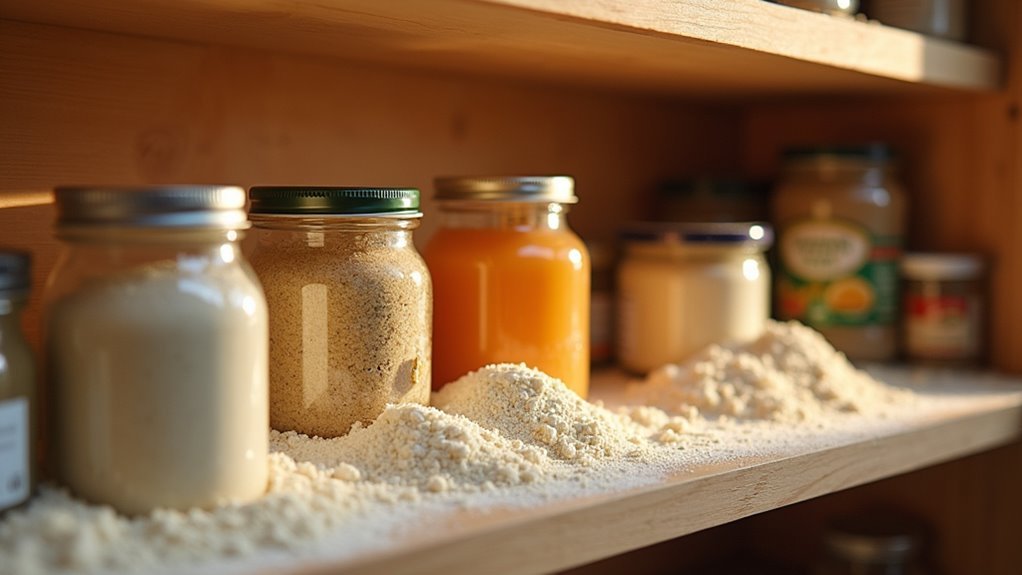
When protecting your pantry from unwanted pests, you’ll want to start by applying a thin layer of food-grade diatomaceous earth along the baseboards and entry points. This creates an effective barrier against ants and cockroaches seeking access to your stored goods.
Use a flour sifter or specialty applicator to guarantee even distribution around pantry perimeters. Focus on targeting cracks and crevices where pests commonly enter.
The key to successful pest control lies in maintaining consistent coverage while keeping the DE dry for peak performance.
You’ll need to reapply regularly, especially during humid conditions, as moisture diminishes its effectiveness.
Always keep the diatomaceous earth away from direct contact with food prep areas to maintain a safe, hygienic environment.
Strategic Bowl Placement for Crawling Pest Traps
Strategic bowl placement transforms your diatomaceous earth into targeted pest traps that intercept crawling insects before they reach your stored food.
You’ll create an effective barrier system by positioning shallow bowls filled with DE at pantry entry points where crawling pests typically enter.
Your strategic placement approach should include:
Position DE bowls strategically throughout your pantry using multiple placement points, elevated positioning, and easily accessible maintenance zones.
- Multiple bowl positioning – Space bowls throughout the pantry to maximize coverage and increase pest encounters
- Elevated placement – Raise bowls slightly off the ground to prevent moisture accumulation that reduces DE effectiveness
- Accessible maintenance zones – Position bowls where you can easily check and refresh the diatomaceous earth regularly
- Food safety priority – Place bowls away from direct food contact areas while maintaining pest interception capabilities
Regular monitoring guarantees your crawling pest trap system remains effective over time.
Layered Food Storage Container Method
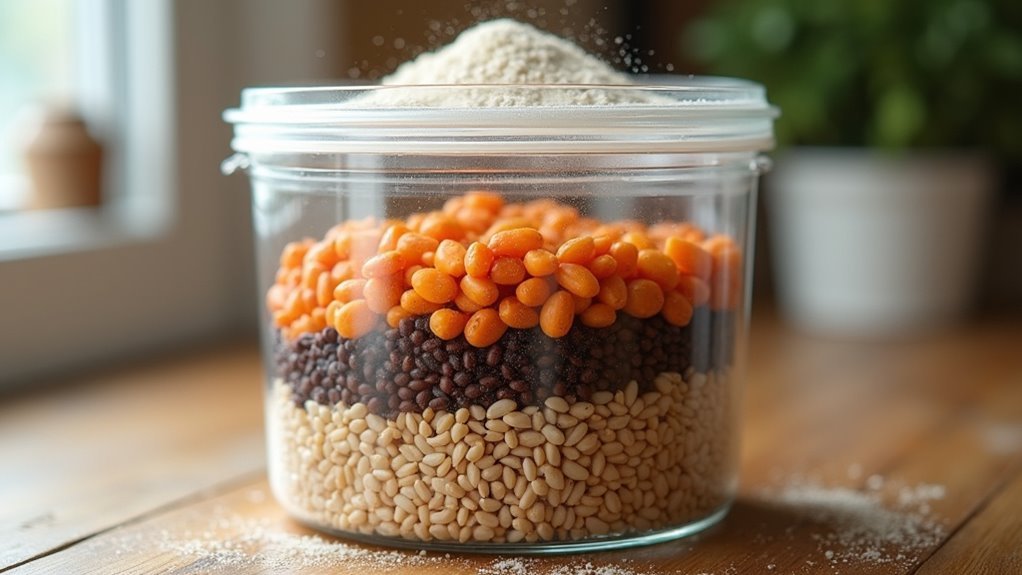
Five distinct layers create an impenetrable fortress within your food storage containers, where diatomaceous earth forms protective barriers between each level of stored goods.
Begin by dusting 100% food-grade DE at your container’s bottom, establishing a moisture-resistant foundation. Add 3-4 inches of grains or legumes, guaranteeing even distribution across the surface. Apply another thin DE layer before continuing this alternating pattern until you’ve filled the container completely.
Gently shake the container to distribute diatomaceous earth throughout all food storage layers, creating consistent pest protection. This systematic approach guarantees every grain receives adequate coverage against insects and moisture damage.
Finish with a final DE layer on top without mixing, then seal tightly. This layered method maximizes your long-term storage effectiveness while maintaining food quality and preventing infestations.
Shelf Lining With Diatomaceous Earth Barriers
You can create an effective pest barrier by applying a thin layer of food-grade diatomaceous earth directly to your pantry shelf surfaces.
Use a kitchen sieve to distribute the DE evenly across each shelf, ensuring complete coverage that’ll deter insects and absorb excess moisture.
Regular maintenance and reapplication will keep this protective barrier working at peak effectiveness, especially in humid conditions where moisture can reduce DE’s pest-fighting properties.
Protective Barrier Application
When pantry pests threaten your dry goods, creating a protective barrier with food-grade diatomaceous earth offers an effective first line of defense.
You’ll dust a thin layer at the bottom of shelves and storage containers to deter insects while absorbing moisture that could lead to mold growth.
For thorough protection, apply diatomaceous earth using these techniques:
- Layer DE between food items to coat all surfaces thoroughly
- Maintain separation between DE and food items for maximum effectiveness
- Check barriers regularly for dampness or contamination
- Replace DE when it becomes compromised to preserve pest-repelling properties
The dual action of pest deterrence and moisture absorption makes diatomaceous earth particularly valuable for protecting grains, flour, and legumes in your pantry storage system.
Even Distribution Techniques
Proper application technique determines how well your diatomaceous earth barrier performs against pantry invaders. You’ll achieve superior results by using a kitchen sieve or sifting scoop to create thin, uniform layers of DE along shelf bottoms and storage containers.
These even distribution techniques guarantee maximum insect-deterring properties while preventing waste.
When using DE in containers, apply alternating layers between food items for extensive coverage. Shake or tip containers periodically to distribute the powder throughout all stored items. This systematic approach assures every surface receives protection.
For long-term storage, finish with a final DE layer on top before sealing containers securely. This method maintains effectiveness without requiring reapplication, making it ideal for bulk storage situations where you won’t access items frequently.
Maintenance And Reapplication
Since diatomaceous earth loses effectiveness when exposed to moisture and heavy foot traffic, you’ll need to refresh your shelf barriers every three to four months for peak pest control.
Proper maintenance guarantees your diatomaceous earth barriers continue protecting your storage areas effectively. When reapplying, completely remove old DE before laying fresh powder to prevent contamination buildup.
Essential maintenance steps include:
- Inspect monthly – Check for gaps, moisture damage, or pest activity signs
- Clean thoroughly – Remove all food debris and old DE before reapplication
- Apply evenly – Shake containers while distributing fresh powder across shelves
- Monitor moisture – Replace immediately if DE becomes wet or clumpy
Regular maintenance prevents infestations from establishing and reduces the need for emergency treatments.
Always dispose of infested items immediately to protect your entire storage system.
Entry Point Dusting for Prevention
You’ll need to locate where pests enter your pantry before applying diatomaceous earth effectively.
Check for cracks around baseboards, gaps near pipes, and openings where walls meet cabinets since these are common insect highways.
Once you’ve identified these entry points, you can strategically dust these zones with food-grade DE to create protective barriers that prevent pests from reaching your food storage areas.
Identifying Pest Entry Points
When protecting your pantry from unwanted invaders, the first step involves conducting a thorough inspection to locate potential entry points where pests can infiltrate your food storage areas.
You’ll need to examine your pantry systematically, searching for cracks, gaps, and openings that provide access routes for ants and cockroaches. Once you’ve identified these vulnerable spots, you can strategically apply diatomaceous earth for effective pest control.
Focus your inspection on these critical areas:
- Baseboards – Check along floor connections for gaps and cracks
- Cabinet edges – Examine where cabinets meet walls or countertops
- Appliance surroundings – Inspect spaces around refrigerators, microwaves, and other equipment
- Wall penetrations – Look for openings around pipes, electrical outlets, and vents
Thorough identification of entry points guarantees your diatomaceous earth application targets the most vulnerable access routes effectively.
Strategic DE Application Zones
After pinpointing where pests can enter your pantry, establishing protective barriers with food-grade diatomaceous earth becomes your next defense strategy.
Focus your DE application on critical zones where pest activity typically originates. Apply thin, even layers along baseboards, creating continuous barriers that insects can’t cross without contact.
Dust around appliances, particularly behind and beneath refrigerators, stoves, and dishwashers where warmth attracts pests. Target cracks in walls, gaps around pipes, and door thresholds where entry points commonly occur.
Use a flour sifter for precise application in tight spaces, ensuring thorough coverage without wasting product.
Maintain these protective zones by reapplying diatomaceous earth after cleaning or when moisture compromises effectiveness, especially in humid conditions.
Mixed Application With Dry Goods Storage
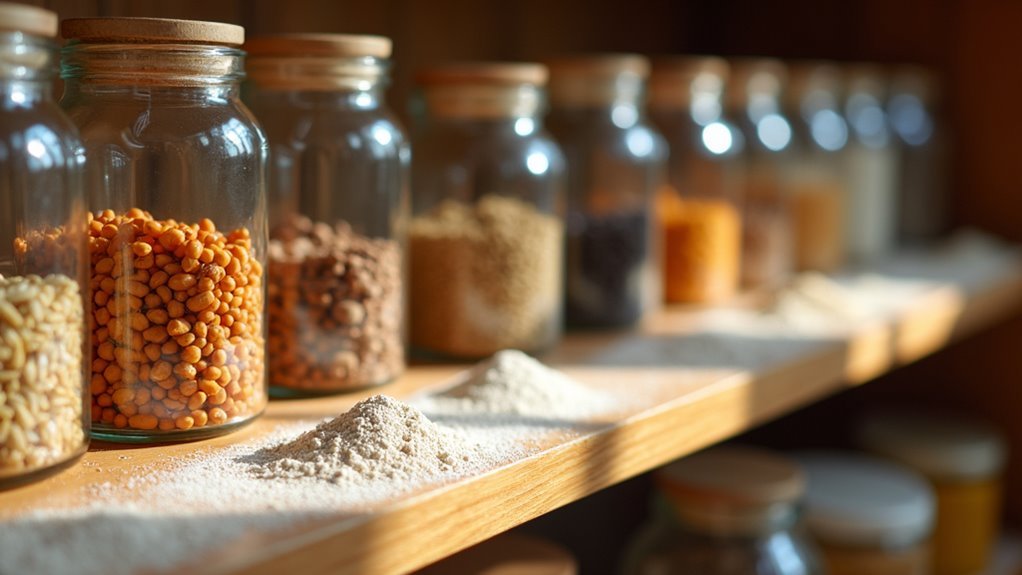
For long-term storage of grains, rice, and other dry goods, mixing diatomaceous earth directly with your food items creates an all-encompassing barrier against pantry pests while maintaining the quality of your stored provisions.
Start by applying a thin layer of food-grade DE at your container’s bottom for initial pest protection and moisture absorption. Mix 1-2 tablespoons of DE per pound of grains throughout your storage.
Begin storage protection by spreading a light layer of food-grade diatomaceous earth in your container’s base, then blend 1-2 tablespoons per pound throughout grains.
Follow this layering process:
- Add 3-4 inches of food on top of the initial DE layer
- Layer food and DE alternately throughout the container
- Apply a final thin layer of DE before sealing
- Shake gently to distribute DE evenly for maximum coverage
Remember to rinse grains before cooking to remove residual DE, though flour can’t be rinsed without losing effectiveness.
Regular Maintenance and Reapplication Schedule
Effective pantry protection with diatomaceous earth doesn’t stop once you’ve completed your initial application and storage setup.
You’ll need to establish a consistent reapplication schedule to maintain DE’s effectiveness as a pest deterrent. Apply a fresh, thin layer every 6 to 12 months under normal conditions. However, if you’re opening containers frequently, increase your reapplication schedule to monthly intervals for continuous protection.
After each application, shake or tip containers to distribute the diatomaceous earth evenly and prevent clumping.
Keep your pantry clean and dry, as moisture greatly reduces DE’s pest-fighting properties. Consider adding desiccant packets alongside your DE treatments for enhanced moisture control.
Always inspect stored items for pest activity during maintenance, immediately disposing of any infested food to prevent contamination spread.
Frequently Asked Questions
Can I Use Diatomaceous Earth in My Pantry?
You can use food-grade diatomaceous earth in your pantry by dusting containers with dry goods. It’ll naturally deter insects, keep food dry, and won’t alter taste while providing safe protection.
How Do You Use Diatomaceous Earth Food Grade for Bugs?
You’ll dust a thin layer of food-grade diatomaceous earth along baseboards, entry points, and pantry areas where bugs travel. Mix 1-2 tablespoons per pound into stored grains for protection.
What Not to Mix With Diatomaceous Earth?
Don’t mix diatomaceous earth with wet foods, oils, fats, sugar, salt, or chemical pesticides. You’ll reduce its effectiveness and potentially attract pests instead of repelling them from your stored items.
What Is the Difference Between Diatomaceous Earth and Food Grade Diatomaceous Earth?
You’ll find that regular diatomaceous earth contains harmful crystalline silica and chemical additives, while food-grade DE is specifically processed to remove toxins, making it safe for consumption and kitchen use.
In Summary
You’ve got seven powerful methods to protect your pantry from unwanted pests using diatomaceous earth. Don’t forget to reapply every few weeks and check your entry points regularly. You’ll want to use food-grade DE only and wear a dust mask during application. With consistent use of these techniques, you’ll create multiple barriers that’ll keep crawling insects out of your stored food items effectively.

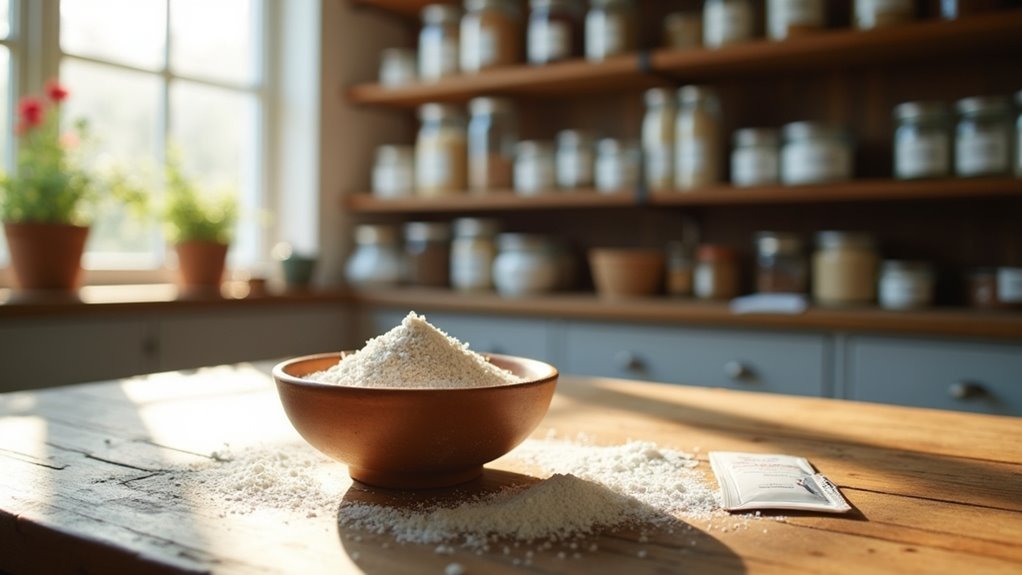
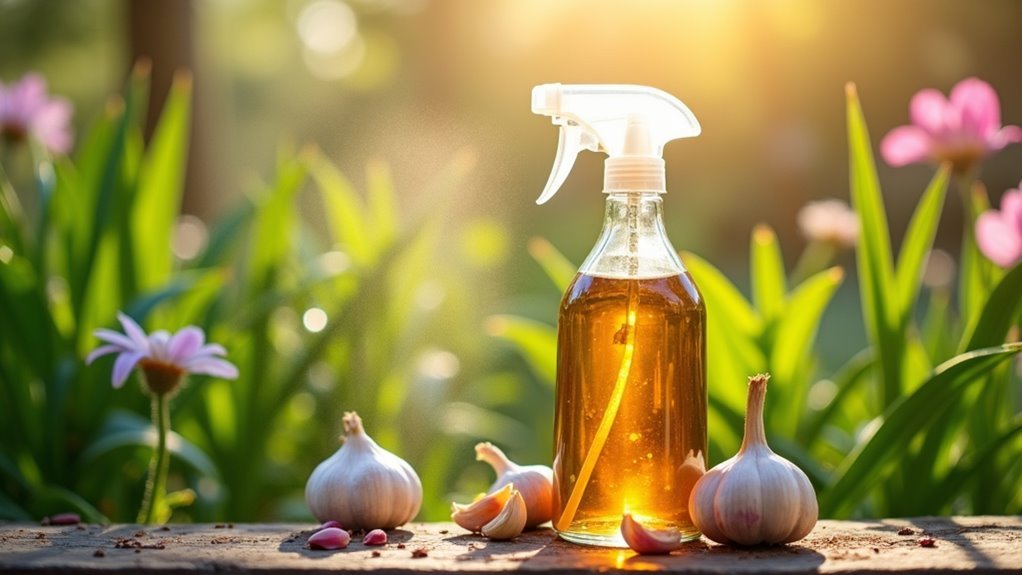

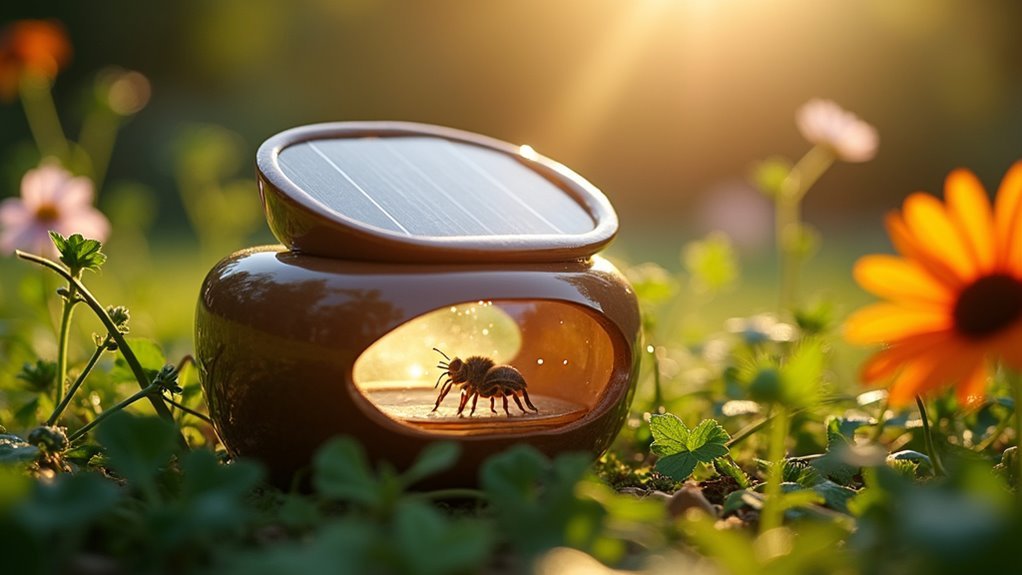
Leave a Reply